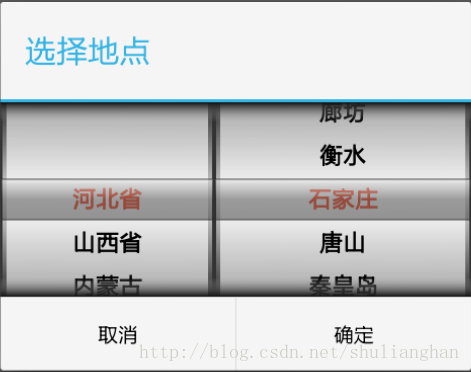博客地址 : http://blog.csdn.net/shulianghan/article/details/41520569
代碼下載 :
-- GitHub : https://github.com/han1202012/WheelViewDemo.git
-- CSDN : http://download.csdn.net/detail/han1202012/8208997 ;
博客總結(jié) :
博文內(nèi)容 : 本文完全地分析了 WheelView 所有的源碼, 包括其適配器類型, 兩種回調(diào)接口 (選中條目改變回調(diào), 和開始結(jié)束轉(zhuǎn)動回調(diào)), 和詳細(xì)的分析了 WheelView 主題源碼, 其中 組件寬高丈量, 手勢監(jiān)聽器添加, 和精準(zhǔn)的繪圖方法是主要目的, 花了將近1周時間, 感覺很值, 在這里分享給大家;
WheelView 使用方法 : 創(chuàng)建 WheelView 組件 --> 設(shè)置顯示條目數(shù) --> 設(shè)置循環(huán) --> 設(shè)置適配器 --> 設(shè)置監(jiān)聽器 ;
自定義組件寬高獲得策略 : MeasureSpec 最大模式 取 默許值 和 給定值中較小的那個, 未定義模式取默許值, 精準(zhǔn)模式取 給定值;
自定義組件保護(hù)各種回調(diào)監(jiān)聽器策略 : 保護(hù)集合, 將監(jiān)聽器置于集合中, 回調(diào)接口時遍歷集合元素, 回調(diào)每一個元素的接口方法;
自定義組件手勢監(jiān)聽器添加方法 : 創(chuàng)建手勢監(jiān)聽器, 將手勢監(jiān)聽器傳入手勢探測器, 在 onTouchEvent() 方法中回調(diào)手勢監(jiān)聽器的 onTouchEvent()方法;
在 Android 中實現(xiàn)類似與 IOS 的 WheelView 控件 : 如圖

獲得組件 --> 設(shè)置顯示條目數(shù) --> 設(shè)置循環(huán) --> 設(shè)置適配器 --> 設(shè)置條目改變監(jiān)聽器 --> 設(shè)置轉(zhuǎn)動監(jiān)聽器
a. 創(chuàng)建 WheelView 組件 : 使用 構(gòu)造方法 或 從布局文件獲得 WheelView 組件;
b. 設(shè)置顯示條目數(shù) : 調(diào)用 WheelView 組件對象的 setVisibleItems 方法 設(shè)置;
c. 設(shè)置是不是循環(huán) : 設(shè)置 WheelView 是不是循環(huán), 調(diào)用 setCyclic() 方法設(shè)置;
d. 設(shè)置適配器 : 調(diào)用 WheelView 組件的 setAdapter() 方法設(shè)置;
e. 設(shè)置條目改變監(jiān)聽器 : 調(diào)用 WheelView 組件對象的 addChangingListener() 方法設(shè)置;
f. 設(shè)置轉(zhuǎn)動監(jiān)聽器 : 調(diào)用 WheelView 組件對象的 addScrollingListener() 方法設(shè)置;
a. 創(chuàng)建 WheelView 對象 :
這里定義了1個適配器接口, 和兩個適配器類, 1個用于任意類型的數(shù)據(jù)集適配, 1個用于數(shù)字適配;
適配器操作 : 在 WheelView.java 中通過 setAdapter(WheelAdapter adapter) 和 getAdapter() 方法設(shè)置 獲得 適配器;
-- 適配器經(jīng)常使用操作 : 在 WheelView 中定義了 getItem(), getItemsCount(), getMaxmiumLength() 方法獲得 適配器的相干信息;
適配器接口 : WheelAdapter;
-- 接口作用 : 該接口是所有適配器的接口, 適配器類都需要實現(xiàn)該接口;
接口抽象方法介紹 :
-- getItemsCount() : 獲得適配器數(shù)據(jù)集合中元素個數(shù);
-- getItem(int index) : 獲得適配器集合的中指定索引元素;
-- getMaximumLength() : 獲得 WheelView 在界面上的顯示寬度;
適配器作用 : 該適配器可以傳入任何數(shù)據(jù)類型的數(shù)組, 可以是 字符串?dāng)?shù)組, 也能夠是任何對象的數(shù)組, 傳入的數(shù)組作為適配器的數(shù)據(jù)源;
成員變量分析 :
-- 數(shù)據(jù)源 :
-- WheelView 最大寬度 :
構(gòu)造方法分析 :
-- ArrayWheelAdapter(T items[], int length) : 傳入 T 類型 對象數(shù)組, 和 WheelView 的寬度;
-- ArrayWheelAdapter(T items[]) : 傳入 T 類型對象數(shù)組, 寬度使用默許的寬度;
實現(xiàn)的父類方法分析 :
-- getItem(int index) : 根據(jù)索引獲得數(shù)組中對應(yīng)位置的對象的字符串類型;
-- getItemsCount() : 獲得數(shù)據(jù)集廣大小, 直接返回數(shù)組大小;
-- getMaximumLength() : 獲得 WheelView 的最大寬度;
NumericWheelAdapter 適配器作用 : 數(shù)字作為 WheelView 適配器的顯示值;
成員變量分析 :
-- 最小值 : WheelView 數(shù)值顯示的最小值;
-- 最大值 : WheelView 數(shù)值顯示的最大值;
構(gòu)造方法分析 :
-- NumericWheelAdapter() : 默許的構(gòu)造方法, 使用默許的最大最小值;
-- NumericWheelAdapter(int minValue, int maxValue) : 傳入1個最大最小值;
-- NumericWheelAdapter(int minValue, int maxValue, String format) : 傳入最大最小值, 和數(shù)字格式化方式;
實現(xiàn)的父類方法 :
-- 獲得條目 : 如果需要格式化, 先進(jìn)行格式化;
監(jiān)聽器作用 : 在 WheelView 條目改變的時候, 回調(diào)該監(jiān)聽器的接口方法, 履行條目改變對應(yīng)的操作;
接口方法介紹 :
-- onChanged(WheelView wheel, int oldValue, int newValue) : 傳入 WheelView 組件對象, 和 舊的 和 新的 條目值索引;
轉(zhuǎn)動監(jiān)聽器作用 : 在 WheelView 轉(zhuǎn)動動作 開始 和 結(jié)束的時候回調(diào)對應(yīng)的方法, 在對應(yīng)方法中進(jìn)行相應(yīng)的操作;
接口方法介紹 :
-- 開始轉(zhuǎn)動方法 : 在轉(zhuǎn)動開始的時候回調(diào)該方法;
-- 停止轉(zhuǎn)動方法 : 在轉(zhuǎn)動結(jié)束的時候回調(diào)該方法;
手勢監(jiān)聽器創(chuàng)建及對應(yīng)方法 :
-- onDown(MotionEvent e) : 在按下的時候回調(diào)該方法, e 參數(shù)是按下的事件;
-- onScroll(MotionEvent e1, MotionEvent e2, float distanceX, float distanceY) : 轉(zhuǎn)動的時候回調(diào)該方法, e1 轉(zhuǎn)動第1次按下事件, e2 當(dāng)前轉(zhuǎn)動的觸摸事件, X 上1次轉(zhuǎn)動到這1次轉(zhuǎn)動 x 軸距離, Y 上1次轉(zhuǎn)動到這1次轉(zhuǎn)動 y 軸距離;
-- onFling(MotionEvent e1, MotionEvent e2, float velocityX, float velocityY) : 快速急沖轉(zhuǎn)動時回調(diào)的方法, e1 e2 與上面參數(shù)相同, velocityX 是手勢在 x 軸的速度, velocityY 是手勢在 y 軸的速度;
-- 代碼示例 :
手勢探測器創(chuàng)建 : 調(diào)用 其構(gòu)造函數(shù), 傳入 上下文對象 和 手勢監(jiān)聽器對象;
-- 制止長按操作 : 調(diào)用 setIsLongpressEnabled(false) 方法, 制止長按操作, 由于 長按操作會屏蔽轉(zhuǎn)動事件;
關(guān)聯(lián)手勢探測器 與 組件 : 在組件的 onTouchEvent(MotionEvent event) 方法中, 調(diào)用手勢探測器的 gestureDetector.onTouchEvent(event) 方法便可;
Scroller 通用作用 : Scroller 組件其實不是1個布局組件, 該組件是運行在后臺的, 通過1些方法設(shè)定 Scroller 對象 的操作 或 動畫, 然后讓 Scroller 運行在后臺中 用于摹擬轉(zhuǎn)動操作, 在適當(dāng)?shù)臅r機 獲得該對象的坐標(biāo)信息, 這些信息是在后臺運算出來的;
Scroller 在本 View 中作用 : Android 的這個自定義的 WheelView 組件, 可以平滑的轉(zhuǎn)動, 當(dāng)我們做1個加速滑動時, 會根據(jù)速度計算出滑動的距離, 這些數(shù)據(jù)都是在 Scroller 中計算出來的;
終止轉(zhuǎn)動 :
-- 終止轉(zhuǎn)動 跳轉(zhuǎn)到目標(biāo)位置 : 終止平緩的動畫, 直接跳轉(zhuǎn)到終究的 x y 軸的坐標(biāo)位置;
設(shè)置轉(zhuǎn)動參數(shù) :
-- 設(shè)置終究 x 軸坐標(biāo) :
-- 設(shè)置終究 y 軸坐標(biāo) :
-- 設(shè)置轉(zhuǎn)動磨擦力 :
設(shè)置動作 :
-- 開始轉(zhuǎn)動 : 傳入?yún)?shù) 開始 x 位置, 開始 y 位置, x 軸轉(zhuǎn)動距離, y 軸轉(zhuǎn)動距離;
獲得當(dāng)前數(shù)據(jù) :
-- 獲得當(dāng)前 x 軸坐標(biāo) :
-- 獲得當(dāng)前 y 軸坐標(biāo) :
-- 獲得當(dāng)前速度 :
獲得開始結(jié)束時的數(shù)據(jù) :
-- 獲得開始 x 軸坐標(biāo) :
-- 獲得開始 y 軸坐標(biāo) :
-- 獲得終究 x 軸坐標(biāo) : 該參數(shù)只在急沖轉(zhuǎn)動時有效;
-- 獲得終究 y 軸坐標(biāo) : 該參數(shù)只在急沖轉(zhuǎn)動時有效;
查看是不是轉(zhuǎn)動終了 :
獲得從開始轉(zhuǎn)動到現(xiàn)在的時間 :
獲得新位置 : 調(diào)用該方法可以獲得新位置, 如果返回 true 說明動畫還沒履行終了;
Scroller 創(chuàng)建 :
手勢監(jiān)聽器 SimpleOnGestureListener 對象中的 onDown() 方法 : 如果轉(zhuǎn)動還在履行, 那末強行停止 Scroller 轉(zhuǎn)動;
當(dāng)手勢監(jiān)聽器 SimpleOnGestureListener 對象中有急沖動作時 onFling() 方法中 : 手勢監(jiān)聽器監(jiān)聽到了 急沖動作, 那末 Scroller 也進(jìn)行對應(yīng)操作;
動畫控制 Handler 中 :
-- 轉(zhuǎn)動 : 獲得當(dāng)前 Scroller 的 y 軸位置, 與上1次的 y 軸位置對照, 如果 間距 delta 不為0, 就轉(zhuǎn)動;
-- 查看是不是停止 : 如果現(xiàn)在距離 到 終究距離 小于最小轉(zhuǎn)動距離, 強迫停止;
-- 履行 msg.what 指令 : 如果需要停止, 強迫停止, 否則調(diào)劑坐標(biāo);
StaticLayout 解析 : 該組件用于顯示文本, 1旦該文本被顯示后, 就不能再編輯, 如果想要修改文本, 使用 DynamicLayout 布局便可;
-- 使用處景 : 1般情況下不會使用該組件, 當(dāng)想要自定義組件 或 想要使用 Canvas 繪制文本時 才使用該布局;
經(jīng)常使用方法解析 :
-- 獲得底部 Padding : 獲得底部 到最后1行文字的 間隔, 單位是 px;
-- 獲得頂部 Padding :
布局創(chuàng)建 :
-- 3種布局 : WheelView 中觸及到了3種 StaticLayout 布局, 普通條目布局 itemLayout, 選中條目布局 valueLayout, 標(biāo)簽布局 labelLayout;
-- 創(chuàng)建時機 : 在 View 組件 每次 onMeasure() 和 onDraw() 方法中都要重新創(chuàng)建對應(yīng)布局;
-- 創(chuàng)建布局源碼 :
監(jiān)聽器集合保護(hù) :
-- 定義監(jiān)聽器集合 : 在 View 組件中 定義1個 List 集合, 集合中寄存 監(jiān)聽器元素;
-- 提供對監(jiān)聽器集合的添加刪除接口 : 提供 對集合 進(jìn)行 添加 和 刪除的接口;
常規(guī)處理方法 : 組件的寬高有3種情況, widthMeasureSpec 有3種模式 最大模式, 精準(zhǔn)模式, 未定義模式;
-- 最大模式 : 在 組件的寬或高 warp_content 屬性時, 會使用最大模式;
-- 精準(zhǔn)模式 : 當(dāng)給組件寬 或高 定義1個值 或 使用 match_parent 時, 會使用精準(zhǔn)模式;
處理寬高的常規(guī)代碼 :
使用下面的自定義組件測試 :
